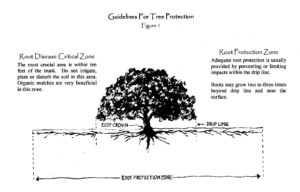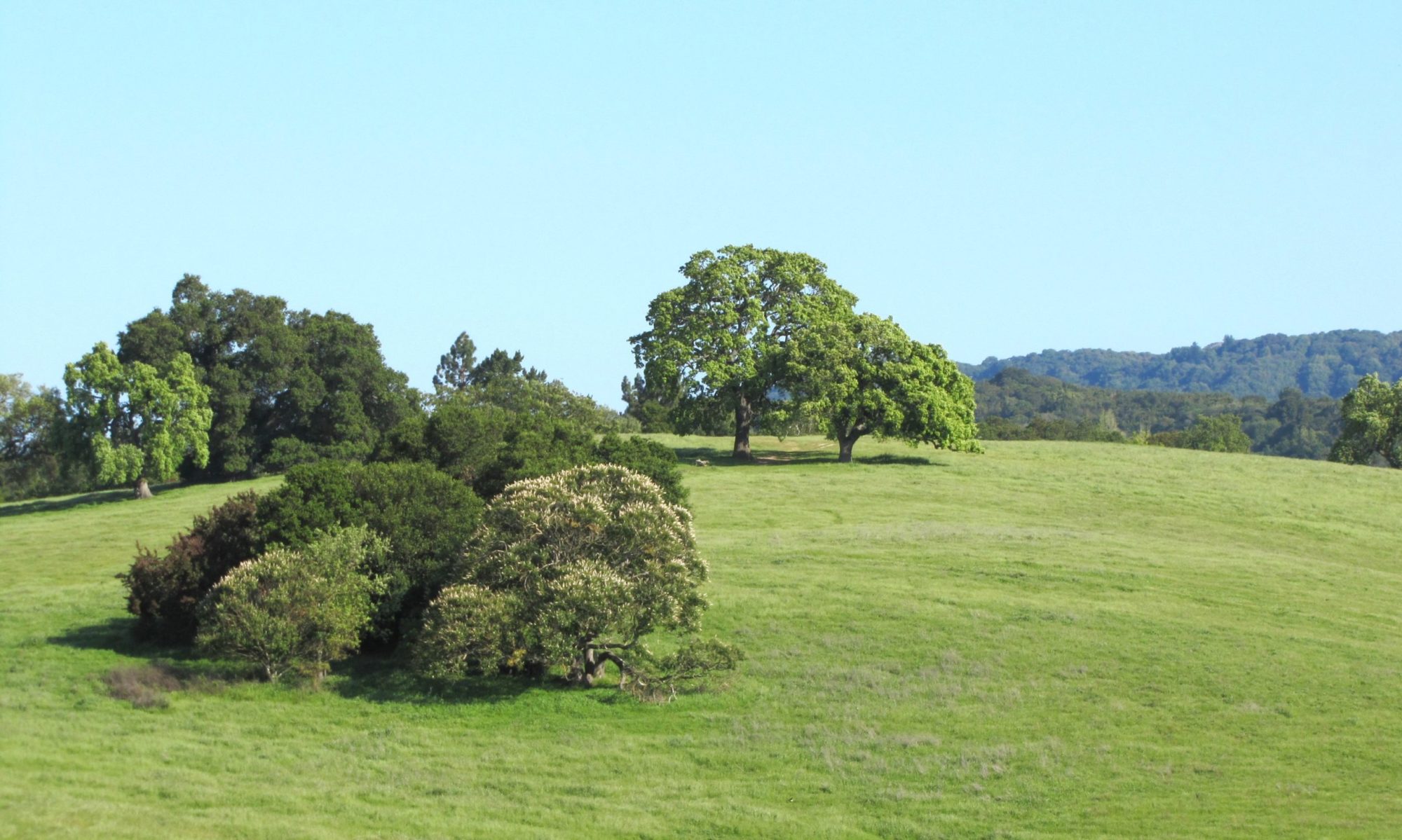Intelligent and dedicated water management is vital for tree health, growth, flowering and fruit development.
Provide water for your trees with love and attention as you would for other living things under your care, like children, and pets. Don't "set it and forget it", manage it! Watch for signs of water deficit, dry cracking soil, wilting foliage, discoloration, decline and die-back.
Water a wide area not just near the tree trunk, water the entire area of the absorbing root zone which spreads as far as the foliar canopy and more. Yes, more than the 'dripline'. Figure 1.5 to 2 times the radius of the dripline to be safe, and to encourage a wide and deep root zone.

Water deeply to wet the soil a minimum of six - eight inches, preferably to 10 - 12 inches.
Check this a few hours after watering, or the next day, by digging down in a couple of spots to see how deep the water infiltrated.
Mulch the soil surface to insulate and help with soil moisture retention and maintain soil organic matter content. Allow full foliar canopy growth without excessive "raising", and nearby plantings to shade the soil and lower tree trunk.
Even native and drought tolerant trees, especially those with altered, unnatural environments, can benefit from a once-a-month deep watering.
Drip irrigation systems can keep trees alive, but are highly unnatural by watering only spots or lines, and are usually not enough water for trees to thrive. Drip is often inadequate and creates drought stress, unless installed and maintained to provide deep watering throughout the full soil surface and soil volume with appropriate frequency for the site and the season.
Frequent shallow watering (multiple times a week), can contribute to poor growing condtions that allows root rot in susceptible trees. Infrequent deep watering is preferred (once a week for water loving trees and once a month for drought tolerant trees). Lawn watering is too much, too frequent for trees and is incompatible for most tree plantings.
All About "Watering Deeply"
From 'The Spruce'. Written by Marie Iannotti
“Every gardener has heard the term "water deeply," meaning that it is better to water deeply once a week than to water superficially more often. What does it mean to water deeply, and how can you tell if you've accomplished it?
There is no hard-and-fast definition for watering deeply, but it generally means that the water is able to soak at least eight inches below the soil surface. The point behind this is that most plant's roots are not sitting close to the soil surface. They have worked their way down into the soil, in search of water and nutrients. This helps protect the plant in times of drought because the soil surface will dry out much quicker than it will below ground, where the soil is cooler. Since you cannot control the rain, there will be weeks when your garden will get much more water than it needs and weeks when it will be your responsibility to see that your garden is watered.
Another common gardening recommendation is to make sure your plants get at least one inch of water every week. One inch does not sound like a lot, and it isn't. That's a minimum. It is better for the plants if the soil gets a good soaking down to at least the eight inches mentioned above...
How to Test How Much Water Your Garden is Getting
How quickly water runs through the soil and how much is absorbed for the roots to access will depend on what type of soil you have, the weather conditions, and how fast the water is being applied.
Water runs through sand much more quickly than it penetrates clay. That's why it is advised you amend both types of soil with organic matter, which is great at holding onto the water just long enough for the plants to get at it. A three-to-four-inch layer of mulch will help conserve whatever moisture is there.
However, there's a simple test to get an approximate idea of how much water is falling on your garden. Water your garden by whatever method you have and then wait a half an hour. At that time, dig down into the soil with a trowel. If it's not wet eight inches or more below the surface, it might be that you haven't watered enough or it could be that you watered too fast and the water ran off elsewhere. It is probably both.
Next time, try a gentler stream of water for a longer period of time. A gentle soak for an hour or two is better than puddling soil around your plants and moving on. It primes the soil to absorb more water and to allow the water to spread out in the soil.
It can take a few tries to get it right, and you don't have to be obsessive about getting exactly eight inches. The point is to make sure the soil is absorbing and holding the water long enough to hydrate the plants. Once you master the concept of watering deeply, your plants will stay healthier in whatever weather comes their way.”
https://www.thespruce.com/watering-deeply-1402418
You can water deeply with an existing irrigation system programed appropriately, or on "manual" setting for customizing the time cycle. Or you can use a hose-end sprinkler. Move it around and position to get full root zone coverage. Soaker hoses linked together and serpentined throughout the root zone is another option.
Avoid setting sprinklers or drip irrigation emitters close to the tree or shrub stems, causing the trunk and root crown to stay wet and incur crown rot.
With sprinklers, you can measure the amount of applied water with a rain gauge. Shoot for one inch to start with as a minimum.
After watering, or no later than the next morning, dig down and see how far the moisture penetrated into the soil profile. I use a soil sampling tube, but a shovel works too. Six to eight inches is a minimum for the trees, 10 to 12 inches depth is better.
For Calfornia native oaks, the following linked article has good information on watering and other considerations:
OAKCARE-Word'05.doc (californiaoaks.org)
For tropical and monsoon climate trees, supplemental watering requirements will be site specific and depend on geographical location and growing conditions.
WHAT'S WRONG WITH DRIP IRRIGATION?
Did you know that most tree roots are in the top 18 inches of the soil, and 50 percent of the roots are located in the top 6 inches?
Most trees have roots that spread out far beyond the dripline, or outermost reach of the branches.
Typically, 50 percent of a tree's roots occur in the zone outside the drip line.
Some tree roots reach laterally the same distance as the height of the tree.
Newly planted landscape trees have roots that grow up to 3 times the spread of the branches (beyond the dripline) within the first three years.

